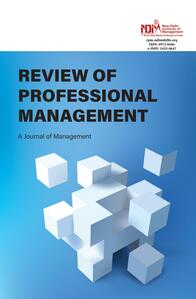
1Department of Business Management, Integral Business School, Integral University, Lucknow, Uttar Pradesh, India

Creative Commons Non Commercial CC BY-NC: This article is distributed under the terms of the Creative Commons Attribution-NonCommercial 4.0 License (http://www.creativecommons.org/licenses/by-nc/4.0/) which permits non-Commercial use, reproduction and distribution of the work without further permission provided the original work is attributed.
The research aims to evaluate the business models of microfinance institutions (MFIs). The major research question is as to what the performance of the MFI Business Model in India was during the COVID-19 situation. The secondary data from 2018 to 2021 is taken across the legal form of MFIs operating all over India. The variables studied include gross loan portfolio (GLP), operating expense ratio (OER), capital adequacy ratio (CAR), finance cost ratio (FCR), active borrower per credit officer (ABCO), return on assets (ROA), return on equity (ROE), YIELD, debt-to-equity ratio (DER) and active borrowers (AB). The statistical technique implemented in the research includes Kolmogorov-Smirnov, Shapiro-Wilk and Levene statistic for testing normality and homogeneity, one-way ANOVA and post-hoc multiple comparisons. The NBFC-MFI (Non-Banking Financial Company-Microfinance Institution) business model is found to be performing well as far as the value creation is concerned. On other dimensions of business model evaluation, that is, value deliverance and value capture, business models of all the categories of MFIs are similar. The result reveals status of business model on value creation, deliverance and capture dimensions during COVID-19.
Business models, legal forms, value creation, value deliverance, value capture, NBFC-MFI and COVID-19
Afuah, A. (2003). Business models: A strategic management approach. McGraw-Hill/Irwin.
Asian Development Bank. (2000). Microfinance policy. Retrieved, 22 January 2023, from http://www.adb.org/documents/policies/microfinance/microfinance0100.asp?p= policies
Badruddin, A. (2017). Conceptualization of the effectiveness of fintech in financial inclusion. International Journal of Engineering Technology Science and Research, 4(7), 960–965.
Badruddin, A. (2024). Measuring service quality of selected microfinance institutions: A gap score analysis.
Badruddin, A., & Anees, M. (2018). An evaluative study of NBFC-MFIs in India. International Journal of Engineering Technology Science and Research, 5(3), 941–947.
Batra, V., & Sumanjeet. (2012). The state of microfinance in India: Emergence, delivery models and issues. https://ideas.repec.org/p/aiu/abewps/37.html
Brown, R., & Rocha, A. (2020). Entrepreneurial uncertainty during the Covid-19 crisis: Mapping the temporal dynamics of entrepreneurial finance. Journal of Business Venturing Insights, 14, e00174. https://doi.org/10.1016/j.jbvi.2020.e00174.
CGAP. (2009, June 5). What is microfinance. Retrieved, 18 May 2016, from http://microfinance.cgap.org/2009/06/05/what-is-microfinance
EDA Rural Systems Pvt Ltd, & SIDBI. (2005, June). The maturing of Indian microfinance: Findings and policy implications from a national study. https://www.findevgateway.org/sites/default/files/publications/files/mfg-en-paper-the-maturing-of-indian-microfinance-findings-and-policy-implications-from-a-national-study-jun-2005.pdf
El Gamal, M., ElKomi, M., Karlan, D., & Osman, A. (2014). Bank-insured ROSCA for microfinance: Experimental evidence in poor Egyptian villages. Journal of Economic Behavior & Organization, 103(Suppl), S56–S73.
Frank, R. H. (2008). Microeconomics and behaviour (7th ed.). McGraw-Hill International.
Hewa-Wellalage, N., Boubaker, S., Hunjra, A. I., & Verhoeven, P. (2022). The gender gap in access to finance: Evidence from the COVID-19 pandemic. Finance Research Letters, 46(A), 102329. https://doi.org/10.1016/j.frl.2021.102329
Kanayi, A. (2009). Emerging trends in the microfinance industry. Finacle from Infosys.
Kumar, S. (2015). Does federating help self-help groups? An empirical study. The Microfinance Review, 7(1), 26–40.
Microfinance Gateway. (n.d.). What is microfinance. Retrieved, 22 January 2023, from https://www.microfinancegateway.org/what-is-microfinance
MicroRate. (2014, May). Technical guide 2014/2, Retrieved, 22 January 2023, from http://www.microrate.com/media/downloads/2014/05/MicroRate_- Technical-Guide-20142.pdf
NABARD. (2022). Status of microfinance in India, 2021–22. Retrieved, 22 September 2025, from https://www.nabard.org/auth/writereaddata/tender/2707225843somfi-2021-22-final-english.pdf
Nandi, A., Nandan, S., & Koshy, S. (2018). The Bharat microfinance report, 2017–18. Sa-Dhan. Retrieved, 22 September 2025, from https://www.sa-dhan.net/bharat-microfinance- report/
Nandi, A., Nandan, S., & Koshy, S. (2019). The Bharat microfinance report, 2018–19. Sa-Dhan. Retrieved, 22 September 2025, from https://www.sa-dhan.net/bharat-microfinance- report/
Nandi, A., Nandan, S., & Koshy, S. (2020). The Bharat microfinance report, 2019–20. Sa-Dhan. Retrieved, 22 September 2025, from https://www.sa-dhan.net/bharat-microfinance- report/
Nandi, A., Nandan, S., & Koshy, S. (2022). The Bharat microfinance report, 2021–22. Sa-Dhan. Retrieved, 22 September 2025, from https://www.sa-dhan.net/bharat-microfinance- report/
Nandi, A., Nandan, S., & Koshy, S. (2023). The Bharat microfinance report, 2022–23. Sa-Dhan. Retrieved, 22 September 2025, from https://www.sa-dhan.net/bharat-microfinance- report/
Osterwalder, A., & Pigneur, Y. (2009). Business model generation. Self-published.
Rappa, M. (2010). Business models on the web. Retrieved, 31 December 2022, from http://home.ku.edu.tr/~daksen/mgis410/materials/Business_Models_on_the_Web.pdf
Reserve Bank of India. (2021). BRICS digital financial inclusion report: India.
Retrieved, 22 September 2025, from https://m.rbi.org.in/scripts/OccasionalPublications.aspx?head=BRICS%20Digital%20Financial% 20Inclusion%20Report
Srinivas, H. (2015). Microfinance—Credit lending models. GDRC Research Output E-059. Global Development Research Center. Retrieved, 17 February 2023, from https://www.gdrc.org/icm/model/model-fulldoc.html
Teece, D. J. (2010). Business models, business strategy and innovation. Long Range Planning, 43(2–3), 172–194. http://dx.doi.org/10.1016/j.lrp.2009.07.003
Watson, D. (2005). Business models. Harriman House.
Uddin, M. H., Akter, S., Mollah, S., & Al Mahi, M. (2022). Differences in bank and microfinance business models: An analysis of the loan monitoring systems and funding sources. Journal of International Financial Markets, Institutions and Moneys 80, 101644. https://doi.org/10.1016/j.intfin.2022.101644